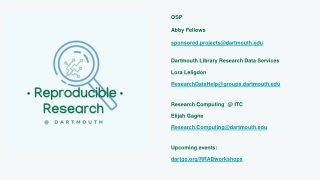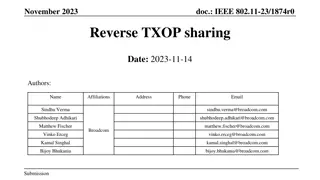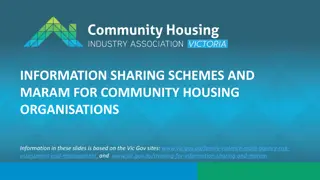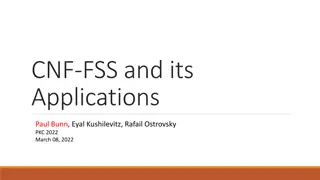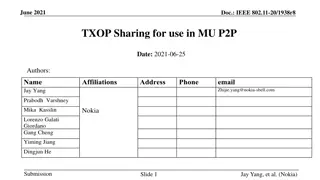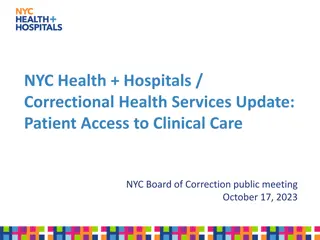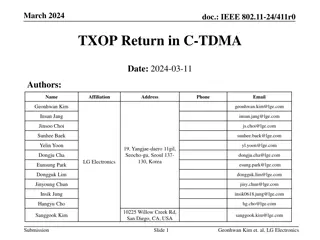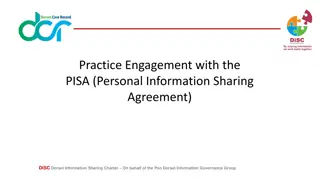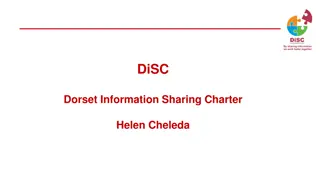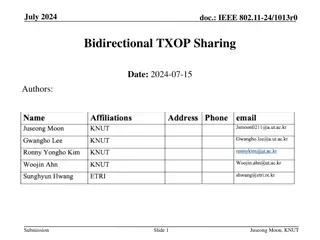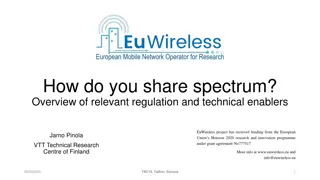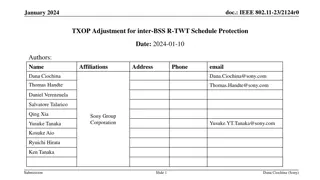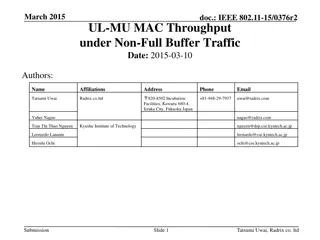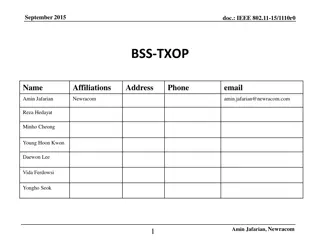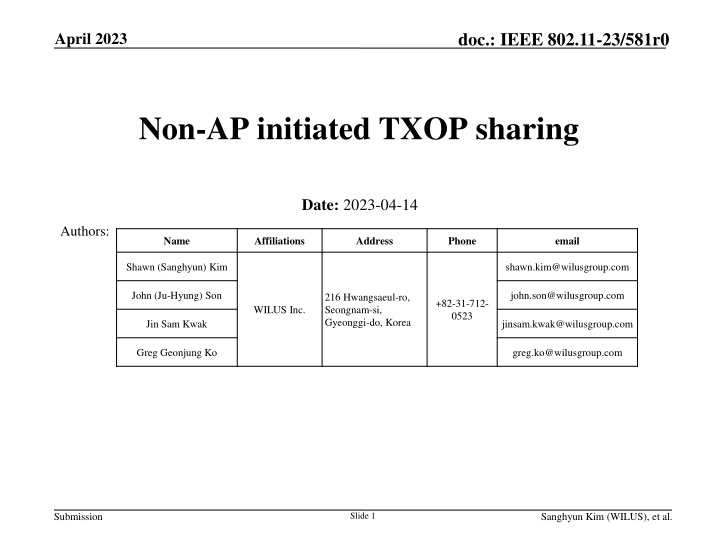
Enhancing AP Manageability Through TXOP Sharing Solutions
Explore how Triggered TXOP Sharing and Reverse Direction protocols can improve latency and jitter in IEEE 802.11 networks by allowing non-AP STAs to share TXOP with APs. Addressing the challenge of limited AP participation in Multi-AP Operation for better network manageability.
Download Presentation

Please find below an Image/Link to download the presentation.
The content on the website is provided AS IS for your information and personal use only. It may not be sold, licensed, or shared on other websites without obtaining consent from the author. If you encounter any issues during the download, it is possible that the publisher has removed the file from their server.
You are allowed to download the files provided on this website for personal or commercial use, subject to the condition that they are used lawfully. All files are the property of their respective owners.
The content on the website is provided AS IS for your information and personal use only. It may not be sold, licensed, or shared on other websites without obtaining consent from the author.
E N D
Presentation Transcript
doc.: IEEE 802.11-23/581r0 April 2023 Non-AP initiated TXOP sharing Date: 2023-04-14 Authors: Name Affiliations Address Phone email Shawn (Sanghyun) Kim shawn.kim@wilusgroup.com John (Ju-Hyung) Son john.son@wilusgroup.com 216 Hwangsaeul-ro, Seongnam-si, Gyeonggi-do, Korea +82-31-712- 0523 WILUS Inc. Jin Sam Kwak jinsam.kwak@wilusgroup.com Greg Geonjung Ko greg.ko@wilusgroup.com Slide 1 Submission Sanghyun Kim (WILUS), et al.
doc.: IEEE 802.11-23/581r0 April 2023 Motivation Improving the tail of the latency distribution and jitter is one of objectives of UHR[1] To improve latency/jitter, the AP needs to perform more flexible scheduling by taking into account the requirements of each STA However, a challenge arises when a non-AP STA is the TXOP holder, as the AP is limited to a passive role as a TXOP responder Moreover, the AP of a BSS where a non-AP STA is a TXOP holder is limited in participating in Multi-AP Operation, which is considered as one of the key functions of UHR Therefore, To enhance the network manageability of the AP that is a TXOP responder, it is necessary to introduce techniques in UHR Slide 2 Submission Sanghyun Kim (WILUS), et al.
doc.: IEEE 802.11-23/581r0 April 2023 Candidate solutions Two solutions can be considered to increase the manageability of AP Option 1: Reusing Triggered TXOP Sharing (TXS)[2] Concept: non-AP STAs share their TXOP with the AP Option 2: Reusing Reverse Direction (RD) protocol Concept: non-AP STAs transmit the RDG PPDU Reusing the TXS procedure defined in EHT could be a better starting point As a RD responder, AP s manageability is still limited (10.29.2 Reverse direction (RD) frame exchange sequence): shall schedule at least one MPDU/Trigger frame for the RD initiator shall trigger full-BW UL MU-MIMO Slide 3 Submission Sanghyun Kim (WILUS), et al.
doc.: IEEE 802.11-23/581r0 April 2023 Recap: Triggered TXOP sharing procedure[3] The TXOP sharing procedure defined in EHT allows an AP to share its TXOP with a non-AP STA, allowing the non-AP STA to manage the frame exchange sequence Slide 4 Submission Sanghyun Kim (WILUS), et al.
doc.: IEEE 802.11-23/581r0 April 2023 Non-AP initiated TXOP sharing Reusing Triggered TXOP Sharing (TXS) The AP can initiate MU operations for its BSS or M-AP operations during the time allocated by the non-AP STA Shared AP Coordinated operations M-AP Ctrl frame Response (e.g., CTS, Trigger frame) DL MU PPDU AP TXOP shared by the non-AP STA1 TX OP Ctrl frame (e.g., TXS) Non-AP STA1 TB PPDU TXOP TB PPDU Non-AP STA2 Slide 5 Submission Sanghyun Kim (WILUS), et al.
doc.: IEEE 802.11-23/581r0 April 2023 Remaining problems Problems Inefficiency in BW utilization BW of the shared TXOP might be limited according to the non-AP STA s operating BW AP cannot fully utilize its performance[4] *Note that there could be still 20 MHz-only STA in the UHR BSS NAV set by the non-AP STA Some APs may not be able to participate in M-AP operation due to the NAV set by the non-AP STA that is a TXOP holder Direction to go The AP should become the TXOP holder, and the bandwidth should be able to expand Slide 6 Submission Sanghyun Kim (WILUS), et al.
doc.: IEEE 802.11-23/581r0 April 2023 Proposed enhancement for the non-AP initiated TXOP sharing During the shared TXOP, the AP can gain the rights to access the wider channel by invoking the backoff procedure and ignoring the NAV set by the non-AP STA AP can determine whether to invoke the backoff procedure *The other STAs do not contend the channel because their NAV is non-zero *The non-AP STA can invoke backoff to perform TXOP recovery during the shared TXOP by the AP (when the TXOP sharing mode is 2) Once the AP obtains the rights, the AP can manage the network as a TXOP holder 320 MHz PPDU (e.g., MU- RTS) IDLE MU & M-AP operations Response frame (P80) 21 0 3 AP TXOP shared by the non-AP STA (P80) TXOP of AP (320 MHz) TX OP Ctrl frame (on P80) Non-AP STA 0 TXOP TXOP has been terminated Slide 7 Submission Sanghyun Kim (WILUS), et al.
doc.: IEEE 802.11-23/581r0 April 2023 Considerations ETSI Regulations[5] AP's channel access for wider BW after the backoff procedure is a regulation-compliant operation (please see APPENDIX) Fair coexistence with legacy BSS There might be a rule for limiting the length of the TXOP for the AP e.g., (End of the AP s TXOP) - (Initial frame of the non-AP STA) TBD threshold Therefore, it may be recommended for non-AP STAs to share their TXOP with the AP as soon as they acquire the TXOP Slide 8 Submission Sanghyun Kim (WILUS), et al.
doc.: IEEE 802.11-23/581r0 April 2023 A brief analysis of the proposed solution Pros Reducing Latency/Jitter Due to the increased manageability of AP TPUT Increase Due to MU/M-AP operations Due to the extended BW Cons Overhead Additional backoff procedure does introduce overhead, but benefits (extra BW & M-AP operation) seem outweigh the overhead Slide 9 Submission Sanghyun Kim (WILUS), et al.
doc.: IEEE 802.11-23/581r0 April 2023 Summary We proposed sharing the TXOP acquired by non-AP STAs with the AP Slide 10 Submission Sanghyun Kim (WILUS), et al.
doc.: IEEE 802.11-23/581r0 April 2023 Straw Poll 1 Do you agree to define a procedure in UHR for a non- AP STA to share its TXOP with the associated AP? Slide 11 Submission Sanghyun Kim (WILUS), et al.
doc.: IEEE 802.11-23/581r0 April 2023 Straw Poll 2 Do you agree to define a procedure in UHR that allows an AP to initiate its TXOP during the time allocated by the non-AP STA? Slide 12 Submission Sanghyun Kim (WILUS), et al.
doc.: IEEE 802.11-23/581r0 April 2023 References [1] 11-23/480r0 UHR proposed PAR (Laurent, Intel) [2] 11-23/41r0 Considerations on Coordinated TDMA (Yanjun, Qualcomm) [3] TGbe D3.0 (35.2.1.2 Triggered TXOP sharing procedure) [4] 11-22/2204r0 Dynamic Subband Operation (Sindhu, Broadcom) [5] ETSI EN 301 893v2.1.50e, 5 GHz WAS/RLAN; Harmonised Standard for access to radio spectrum https://www.ieee802.org/11/private/ETSI_documents/BRAN/05- CONTRIBUTIONS/2023/BRAN(23)118013r3_Rapporteur_s_copy_of_EN_301 _893.zip Slide 13 Submission Sanghyun Kim (WILUS), et al.
doc.: IEEE 802.11-23/581r0 April 2023 Appendix (ETSI regulations) Summary (4.2.7.3.2.3 Multi-channel operation)[5] Option 1 Device may use any combination/grouping of channels, if it satisfies the channel access requirements for an initiating device on each such operating channel Need to separately gain the right to access each channel (per-20 MHz) Option 2 Device that uses a combination/grouping of adjacent 20 MHz channels that is a subset of the 40/80/160 MHz channels may transmit on any of the 20 MHz channels, if: The device has gained the right to the primary channel as defined in 4.2.7.3.2.6 and The device performs CCA of at least 23 us immediately before the intended transmission on each of the other operating channel *4.2.7.3.2.6 is equivalent/similar to the backoff procedure of Wi-Fi Slide 14 Submission Sanghyun Kim (WILUS), et al.

